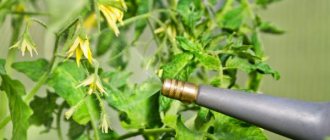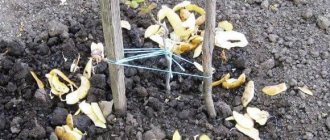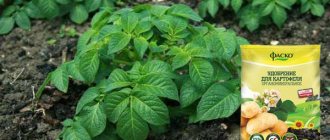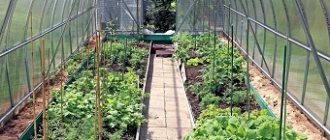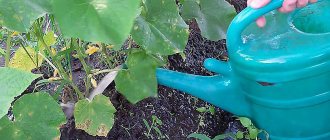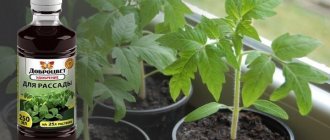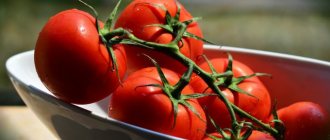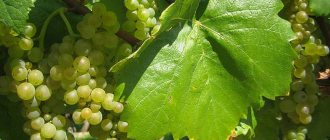Characteristics of potassium monophosphate
Fertilizer containing potassium and phosphorus. The substance is easily soluble: at a water temperature of 20 ° C it mixes with it by 22.6%, and at 90 ° C – by 83.5%. In a chemically pure state they are colorless crystals.
Fertilizer composition
Monopotassium phosphate is produced and is a powder containing 28% potassium and 23% phosphorus. The composition of the fertilizer is potassium monophosphate given in the form reduced to the active ingredients, since when interacting with humates in moist soil, the substance disintegrates and the residues combine with oxygen. The chemical formula of potassium monophosphate (MPP) is KH2PO4.
Potassium monophosphate fertilizer does not contain heavy metals and sodium salts that adversely affect the development and growth. The absence of the specified substances increases the plant’s immunity.
Mechanism of action and properties
After the potassium monophosphate fertilizer is dissolved in water and used for the root system, nutrients are immediately delivered to all tissues without wasting time on chemical reactions in the soil. The potassium monophosphate fertilizer remaining after being absorbed into the plant is in the ground and continues to nourish the root system. MFC has a number of properties:
- increased fruiting;
- improving the taste of fruits;
- assistance in the fight against disease;
- increase in the number of fruits on bushes and trees.
Advantages and disadvantages
Nevertheless, the use of potassium monophosphate in agricultural technology is more than justified, especially on small and medium-sized areas if there are possibilities for manual individual processing of plants. In such conditions, the relatively high (but not excessively high) cost of the drug is more than compensated by the increase in yield.
Potassium monophosphate as a fertilizer has a trace. advantages:
- The ratio of active K and P in the preparation is optimal for maximum fruiting, as well as increasing plant resistance to diseases, pests and frosts;
- Potassium monophosphate, more than other phosphorus-potassium fertilizers, promotes the formation of lateral shoots with peduncles, which is essential for flowers, except for cutting (see also below);
- High solubility causes rapid migration of active substances and ease of their absorption by plants;
- Potassium monophosphate is absorbed by all parts of plants;
- It is almost impossible to overfeed plantings with potassium monophosphate; this advantage is a consequence of one of its disadvantages, see below;
- Potassium monophosphate is fully compatible with pesticides, up to the preparation of a single tank solution for complex treatment;
- Potassium monophosphate itself is a good means of preventing and combating powdery mildew and other diseases. other fungal diseases;
- The absence of ballast substances guarantees the absence of side effects from the fertilizer;
- Potassium monophosphate has virtually no effect on soil acidity;
- Potassium monophosphate is also beneficial for beneficial soil microflora. This is very important for greenhouse farming: drying out of the soil with seemingly sufficient watering in greenhouses regularly fed with this fertilizer is a rare exception, because microorganisms involved in soil structuring are in comfortable conditions.
Note: point 10 is also important because it allows you to reduce water consumption for humidifying the greenhouse. Given the current tariffs for it, you will agree, this is significant.
About compatibility with nitrogen
Plants will respond well to phosphorus and potassium only if they have healthy, powerful green mass, which requires nitrogen. There are no serious contraindications to the use of potassium monophosphate together with nitrogen fertilizers, but it is better not to take risks by preparing a common solution of both. The high activity of potassium monophosphate makes it possible to reduce the gap between potassium-phosphorus and nitrogen fertilizing to a minimum of 2-5 days; the wetter the weather, the shorter the gap. Nitrogen should be given after phosphorus and potassium, except for nitrogen-fixing plants: legumes, clover, alfalfa.
Note: Saintpaulia violets are also nitrogen fixers. They can be fed with monopotassium phosphate alone. If signs of nitrogen starvation appear, it is useless to add nitrogen; incorrect maintenance conditions are to blame - little light, heavy, poorly permeable soil or acidic soil.
An excellent mineral fertilizer in general, potassium monophosphate is not without its drawbacks:
- Potassium monophosphate does not accumulate in the soil and decomposes very quickly, so fertilizing with it is carried out only in solutions (see below). Adding solid potassium monophosphate to the soil will not harm the plants, but it will not do any good - all the fertilizer will be lost;
- As a consequence of the previous etc., potassium monophosphate is not suitable for pre-winter preparation of plantings in open ground, except in certain cases, see below;
- Also, due to point 1, potassium monophosphate is most effective in the warm season of a favorable year - not hot and moderately humid. In greenhouses - with sufficient lighting and regular ventilation;
- Another negative consequence of point 1 is that weeds taste and use potassium monophosphate no less than cultivated plants. Therefore, its use in the garden or vegetable garden can only be recommended to cultivated owners who have enough time and means to control weeds. At a weekend dacha, weeded occasionally, potassium monophosphate will cause the area to become overgrown with anything other than what is needed;
- Potassium monophosphate is hygroscopic and, when wet, loses its properties. Working solutions are unstable in air and light. Therefore, you need to purchase the drug in packages suitable for single use, and use the working solution immediately after preparation.
- Potassium monophosphate is completely incompatible with magnesium and calcium fertilizers, which seriously limits its use for certain crops, see below;
- The ability to cause increased tillering limits the use of potassium monophosphate for cut flowers. Even if the brushes/inflorescences are cut, the cuttings are too short for a vase or bouquet, and the marketability and profitability of the products are low;
- As a highly active fertilizer, potassium monophosphate is not suitable for slowly growing and/or dormant indoor plants - all succulents, orchids, azaleas, gloxinias, strepocarpus, cyclamen, abutylene, dodecatheon, etc.
Note: the author once saw, on a plot of land whose owners madly relied on potassium monophosphate, a thistle 4.5 m high (!) and with a stem as thick as a healthy man’s arm. Vo grew big thanks to tomatoes and potatoes! The hedge trimmer didn't take it, so I had to cut it down. The core was as hard as ivory, and the thorns would make a good rake. I imagined plantations of such mutants for technical purposes - interesting, but not in the countryside for winter help.
Monopotassium phosphate and grapes
Grapes need magnesium more than other berry plants, so under normal conditions we do not recommend potassium monophosphate for fertilizing vineyards. Typically, grapes are fed with potassium magnesia in the second half of summer and in preparation for winter. But it is not a particularly active fertilizer: it migrates in the soil and is absorbed by plants slowly, but it leaches well. Therefore, if the year turns out to be cool and wet, the vines do not have time to get enough potassium, winter is difficult, and the harvest the next year is poor. In this case, intensive pre-winter preparation of grapes using potassium monophosphate will be justified, see video:
Video: feeding grapes with potassium monophosphate before winter
Instructions for use depending on the type of crop
The concentration of the potassium monophosphate mixture depends on the type of plant, as well as on the season in which feeding is carried out. By strictly following the instructions, you can avoid excessive consumption of fertilizer and get the highest quality harvest.
Watering potassium monophosphate should be carried out in 2 stages: this way the plants will receive maximum support.
Below we will look at the instructions for using the “potassium monophosphate” fertilizer for specific crops.
Seedling
Produced in a gentle manner only after the appearance of 3 true leaves with a 0.07% solution. The soil must be moistened before irrigation. The seedling must be protected from direct sunlight. Feeding potassium monophosphate is carried out in two stages. First, when 2-3 leaves appear, watering is done with a solution of 10 g and 10 liters of water. The second application is carried out 10-15 days after planting in the soil with a solution of the same concentration.
Tomatoes
Instructions for the use of potassium monophosphate for tomatoes prescribe twice treatment with a mineral agricultural product for the entire active growing season. The concentration for both applications is 15 g per 10-liter bucket of water. The first feeding is carried out when the fruits appear, the second – after 15-20 days.
Application for tomatoes
Potassium mixtures for growing tomatoes are of paramount importance. The taste, shape and size of the fruit depend on the presence of the substance in the soil. Tomatoes do not tolerate chlorine, so this fertilizer is a suitable mixture for them.
The first feeding should be done when the seedlings have 3 true leaves . The second - after disembarkation 2 weeks later . For seedlings, 9–10 grams per 10 liters of water will be enough . Before the period of fruit set, the dosage can be increased to 15 grams per bucket of water .
Potassium monophosphate and other potash fertilizers
The main advantage in comparison with similar fertilizers is that it promotes the formation of side shoots with flower stalks. But if you grow large-flowered varieties for cutting, bushiness, on the contrary, will become a significant drawback.
Potassium monophosphate is also considered an ideal fertilizer for tomatoes, as it contains all the substances they need. Potassium chloride is contraindicated for this crop, as well as for some other chlorine-sensitive plants. In addition, potassium monophosphate is suitable for foliar feeding, which not all potash fertilizers can boast of.
Properties
Potassium monophosphate is highly soluble in water. When fertilizing the soil, phosphorus is absorbed by 23%, potassium by 28%. Phosphorus takes part in vegetation and photosynthesis. Its deficiency negatively affects:
- height;
- bloom;
- fruit formation.
If there is enough of it in the soil, then the plant gains mass faster, more flowers and ovaries are formed, and the leaves become greener. The root system will become more branched in a short time.
Potassium is necessary for water-salt metabolism. The use of potassium monophosphate helps to increase the overall immunity of plants.
With a lack of potassium, fruits quickly become lethargic and are poorly stored. It is not necessary to use it together with calcium and magnesium salts, since the effectiveness of fertilizing is reduced.
It is recommended to prepare the powdered form in boiled or distilled water. The granular preparation can be dissolved even in well, simple tap and spring water. Good solubility contributes to good absorption of fertilizer by the plant. Thanks to this fertilizer, crops become more resistant to minor return frosts.
Reviews about the use of potassium monophosphate
Reviews about the use of this fertilizer are both positive and negative:
Alena Tushko: “I used a solution of potassium monophosphate to spray potatoes. I can’t say that I’m very pleased with the result, since, on the one hand, the plants did not suffer from anything during the entire period of their growth, but, on the other hand, the harvest was significantly smaller compared to previous years. Maybe this season turned out to be a lean season, I don’t know. But I don’t plan to use this fertilizer anymore.”
Maxim Zakharchenko: “I use a solution of potassium monophosphate to treat seedlings. With its help, plants grow much faster and produce a generous harvest. To increase the effectiveness of the product, I alternate its use with watering with nettle infusion or sprinkling the soil with wood ash. But I fertilize very rarely - only when I see that the plants do not have enough nutrients. I can recommend monopotassium phosphate for use based on personal observations. However, in order not to harm the crops, the dosage of the product must be strictly observed!”
Potassium monophosphate is an affordable fertilizer that is used in gardening and gardening. It is used to process fruit crops and ornamental plants. In most cases, the product shows high effectiveness, so if you notice clear signs of a lack of nutrients in plants, spray or water them with this solution according to the instructions. And pretty soon you will see significant changes for the better.
Features of potassium monophosphate, physical and chemical properties
In the language of chemistry, this is potassium dihydrogen orthophosphate, i.e. potassium salt of orthophosphoric acid, having the formula KH₂PO₄. As the name suggests, potassium monophosphate (or otherwise - monopotassium phosphate) is a substance whose main components are potassium (33%) and phosphorus (50-55%). Of all the phosphorus compounds of potassium, only monophosphate is used as a fertilizer. The product is available in the form of a white crystalline powder, highly soluble in water. This makes the drug especially effective for foliar feeding and in drip irrigation systems. In a 1% solution it has high acidity (pH 4.0-4.5), and it is this fact that causes the most controversy among gardeners.
The industry widely uses the food additive E340, which is potassium orthophosphate - the substance discussed in the article. It is actively used in large industries as an emulsifier, color fixer, acidity regulator and taste stabilizer.
How to replace Potassium Monophosphate for tomatoes
This fertilizer differs from others in that the phosphorus contained in it is easily absorbed by garden crops. Other medications must be added a year in advance for this element to take effect.
Analog of Potassium Monophosphate – Pekacid
You can replace potassium monophosphate with superphosphate and potassium nitrate. But the only substance with a similar composition is Pekacid. But this fertilizer is more expensive than Potassium Monophosphate.
Composition of Pekacid:
- phosphorus – 60%;
- potassium – 20%

